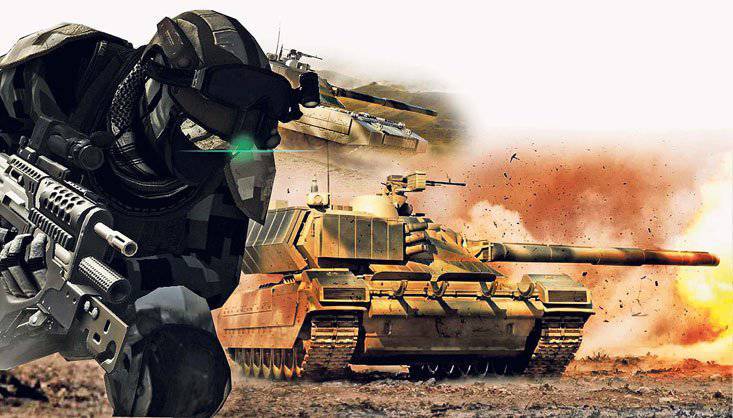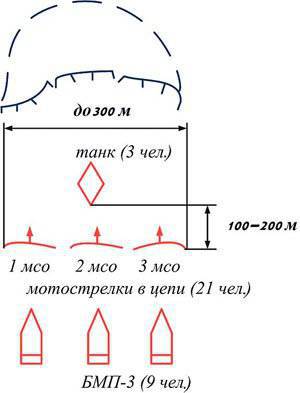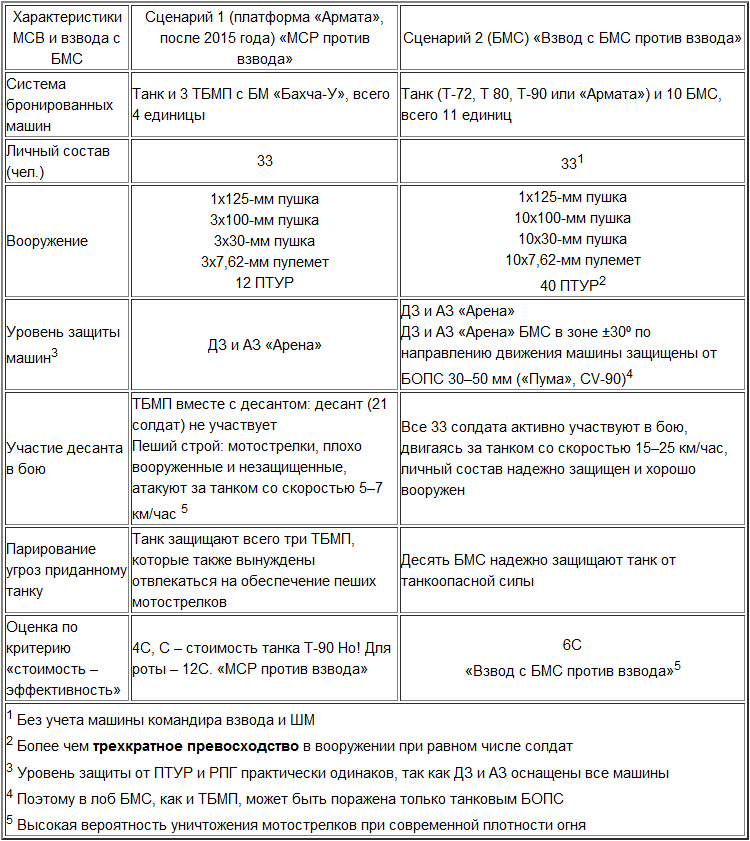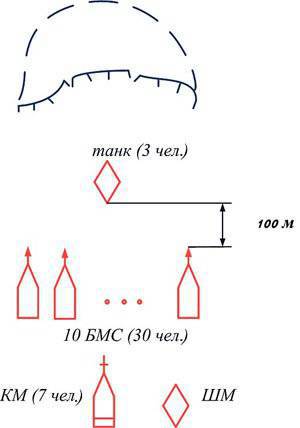From soldier’s combat vehicles to robots
The attack on infantry fighting vehicles (armored personnel carriers) is used on the available terrain during the attack on the enemy, hastily turned to defense, in the absence of organized resistance, and also in the case when the defense of the enemy is reliably suppressed and most of its anti-tank weapons are destroyed. We publish discussion material on the search for the best ways to protect motorized rifle subunits when attacking fortified positions.
So you can not act
The tactics of infantry attack on enemy defenses were tested during the Great Patriotic War. At first, the enemy’s defense was fired from cannons, mortars, multiple launch rocket systems, and a bomb was fired at it. When attacking for tanks infantry moved on foot. In front of the tanks, a moving fire shaft was organized (explosions of their shells and mines) at a distance of at least 200 meters. The infantry suffered heavy losses from rifle bullets. weapons and splinters.

It has been almost 70 years since. How should modern motorized rifle subunits (platoon, company and others) attack the enemy? The tactics of attack of a motorized rifle platoon (company) depends primarily on the armored vehicles that are in service with the Ground Forces (SV). Currently, these are tanks (T-90 and others) and infantry fighting vehicles (BMP-3 and others). Theoretically, there are two possible platoon attacks, if any.
The first is that a tank takes part in the attack, three BMP-3 with 30 soldiers are moving behind it (nine people are the crew and the 21 is a landing party). In this case, the landing in the BMP begins to move from the line of attack and practically does not participate in the battle until it is landed from the vehicles.
 In the second variant, a motorized rifle platoon (MSV) attacks as follows: in front of the tank, then motorized riflemen on foot, and behind them are three BMP-3, which fire at the motorized rifleheads. It is these two variants of attack that are prescribed by the modern Combat Regulations on the preparation and conduct of combined arms combat, which was put into effect by the order of the Commander-in-Chief of the Land Forces - Deputy Minister of Defense of the Russian Federation of 31 August 2004 No. 130 (Part 2. Battalion, company. Part 3. Platoon, squad, tank).
In the second variant, a motorized rifle platoon (MSV) attacks as follows: in front of the tank, then motorized riflemen on foot, and behind them are three BMP-3, which fire at the motorized rifleheads. It is these two variants of attack that are prescribed by the modern Combat Regulations on the preparation and conduct of combined arms combat, which was put into effect by the order of the Commander-in-Chief of the Land Forces - Deputy Minister of Defense of the Russian Federation of 31 August 2004 No. 130 (Part 2. Battalion, company. Part 3. Platoon, squad, tank).Figure 1 shows the scheme of an attack of the MRV on foot on the fortified enemy defenses under the current Battle Regulations. A tank moves ahead, behind it - on foot, three motorized rifle squads (MCOs), a total of 21 people. Next - three BMP-3 (crew - three people each). The commander of the attacking platoon is one of the commanders of the BMP-3.
What are the main disadvantages of this tactic?
If the first variant is implemented (attack by infantry fighting vehicles with assault forces), then the probability of the death of three combat vehicles together with 30 soldiers is great, because the BMP-3 is front-vulnerable for armored-piercing piercing projectiles equipped with modern 30 – 50 millimeters used by modern foreign BMP Puma. (Germany), CV-90 (Sweden) and others. The armor penetration rate of these projectiles reaches 200 millimeters when interacting with the target machine normal to a distance of up to 100 meters. The aluminum side of the BMP-3, with a thickness of 40 of millimeters, is penetrated by the armor-piercing 20 – 40-mm projectiles at almost any angle. The main disadvantage of this attack is that the landing (21 man) is not actually involved in the battle.

Consider the second option attack. The speed of movement of the shooters is small (five to seven kilometers per hour), the soldiers have poor protection (body armor). Weapons (automatic, RPG) are practically unsuitable for combat with enemy fire points (tanks dug into the ground, infantry fighting vehicles, armored personnel carriers, concrete pillboxes). Therefore, it is likely that all three MCOs will be destroyed even before they approach the leading edge of the enemy defense.
Thus, modern armored vehicles (BMP-1, BMP-2, BMP-3, BTR-80, BTR-90) are unsuitable for conducting a successful attack against the fortified defense of the enemy and in its depth. Their use does not prevent a high probability of the destruction of soldiers and officers of motorized rifle units, as well as equipment. Both options, prescribed by the Battle Regulations for attacking the fortified defenses of the enemy, are not suitable.
The problems are the same
Currently, the Russian Ministry of Defense has stopped the purchase of tanks and infantry fighting vehicles, but it conducts development work on the creation of three types of armored vehicles: heavy - tracked (tanks and "heavy" infantry fighting vehicles), medium - on wheels (BTR) and light (Tiger type armored vehicles) ). In relation to the topic of this article, we are interested in the "heavy" BMP (TBMP) on the Armata platform, which should be designed on the same base with the new tank by the 2015 year. However, the future combat vehicle system will also be unable to eliminate the costs of the considered variants of an attack on the fortified enemy defenses.
The first option (for MSV): the defense of the enemy is attacked by the Armata tank and three TBMPs with a landing force on board (most likely 21 people), who do not participate in the battle during the attack. There is a high probability of the destruction of these TBMP together with the crews and the landing force (a total of 30 people). For this, ammunition can be used that the national active and dynamic defense parries poorly: tank fire alarm equipment M829A3 (USA) with armor-piercing 800 millimeters; cumulative ammunition operating on the span over the roofs of vehicles - ATGM Bill (Sweden), Tow 2B (USA); self-targeted cluster munitions with a shock core - SMArt-155 (Germany), SADARM (USA).
In the second variant of the attack behind the tank, the chain of motorized riflemen is still on foot, with three TBMPs behind it. Poorly defended and poorly armed infantrymen are essentially polygon targets for defending soldiers. Therefore, there is a high probability that they will be completely destroyed during the attack, and even more so in the depth of the enemy defenses.
Thus, the fundamental shortcomings of the attack variants with the use of modern armored vehicles (weak security of dismounted motorized infantry units, a high probability of destroying the TBMP with the landing force, non-participation of the landing force in the combat vehicles) are not eliminated.
Consequently, if the re-equipment of the Ground Forces to the TBMP takes place, which will require multibillion-dollar costs, the combat capability of the infantry units will remain in the same unsatisfactory condition as it is today.
The main mistake in the formation of a system of armored combat vehicles for motorized rifle subunits (platoon, company) is that the BMP (BMP-3 and the projected TBMP - heavy tracked "Armata" and medium-tracked "Kurganets-25") are endowed with two functions: 1) transportation of troops in the front line, participation in the defense of our forces; 2) participation in the attack on the enemy defense and in the battle in the depth of the enemy defense. For performance of the second function, the BMP is unsuitable even in the case when it has protection at the tank level.
BMS required
We propose to have two specialized vehicles: one for the transport of troops in the front-line zone (for example, BMP-3) and the second, most adapted for contact combat during an attack and defense breakthrough. Such a machine must have the necessary weapons to fight buried tanks, infantry fighting vehicles, armored personnel carriers, dots, infantry in the trenches, reliable protection against massive fire, mobility not less than tanks, the minimum number of soldiers in the attacking vehicle.
In this case, another attack tactic is needed fortified defense. It involves both traditional combat vehicles (upgraded T-72, T-80, T-90 or Armata) and ten soldier combat vehicles (BMS). The crew of each BMS consists of three people - the commander, the gunner and the driver.
 Figure 2 shows the attack pattern of a BMS platoon: a tank (three people), a BMS (30 man) and a command vehicle (four people). All 37 motorized infantry units are actively engaged in combat during the attack. They are well protected and armed.
Figure 2 shows the attack pattern of a BMS platoon: a tank (three people), a BMS (30 man) and a command vehicle (four people). All 37 motorized infantry units are actively engaged in combat during the attack. They are well protected and armed.In the platoon with BMS, it is also advisable to have an assault vehicle (BL). BMS uses the modular principle of armor protection. Without removable armor, the BMS mass is 12 – 14 tons, and with removable armor, 25. The machine in the version with a mass of 12 – 14 tons can be used by the Airborne Forces. The equivalent thickness of armor penetration in the frontal projection of the BMS is at least 200 millimeters, and from the side - 100. The frontal part of the BMS is able to withstand the blow of modern BOPS to 30 – 50-millimeter cannons, and the side armor “holds” this projectile at an angle of 60 degrees from the normal.
BMS should have the following types of protection: active Arena-type and modern dynamic against cumulative anti-tank guided missiles (ATGM) and hand-held anti-tank grenades (RPG). BMS can be successfully used in combat in cities and mountains. The ratio of engine power to mass and the pressure on the ground at the BMS is not worse than that of the tank.
BMS can be quickly and relatively cheaply (cheaper than the base BMP) created on the basis of the BMP-3, since these machines use the same combat compartment (combat module - BM) "Bakhcha-U" (100-mm rifled gun with 40 high-explosive fragmentation ammunition, 30-mm cannon with 500 shells, 7,62 mm machine gun with 2000 ammunition, four ATN caliber 100 mm), and the same engine-transmission compartment with UTD-32 CTX engine. forces The main difference between the BMS (it does not have a landing) and the BMP-660M (with the landing) is in the material of the hull. Modular armor - in the first case, aluminum - in the second. In addition, these machines have different sizes: BMS is almost 3 times shorter than the BMP-1,5. The mass of the BMP-3M and BMS is almost the same.
Preliminary calculations showed that if the cost of a TBMP is comparable to the cost of a tank, and the cost of a BMS is not higher than the cost of a BMP-3, which is half the cost of a T-90 tank, then the cost of armament of a platoon in the first scenario will be 4С, where C is the cost of a T-tank 90. The cost of a platoon armament in the second scenario is 6C.
However, the increased security and firing capabilities of a platoon with BMS (second scenario) make it possible to use in the offensive not a motorized infantry company (msr, 12 combat vehicles and 99 soldiers) against a defending platoon, as prescribed by the Battle Rules, but only one platoon with BMS. In this case, the “cost of the attack” in the second scenario will be two times less (6С vs 12С). By the way, it requires research to determine the optimal size of the front in the second scenario.
Ways to improve
The effectiveness of a platoon with a BMS can be significantly increased if an assault machine (CMM) is added to the tank-10 BMS system, which can be created by modernizing the T-72, T-80, T-90 tanks or on the basis of the Armata platform. In this case, the 125-mm gun is replaced by a 152-mm howitzer firing the same shells (OFS, adjustable “Centimeter” or controlled by “Krasnopol”) as the self-propelled howitzer “Msta”. CMM allows you to increase the maximum firing range for a platoon from seven to 13 kilometers. However, in many cases there is no need to turn to the help of long-range artillery or aviation, which gives a gain in time and accuracy in hitting the target. This allows you to implement the principle of "saw - shot."
The most important problem for the BMS platoon is shooting at the invisible targets of the OFS and guided projectiles of the type “Arkan” and “Krasnopol”. To ensure effective firing, UAVs with a range of 20 – 25 kilometers of the Aileron-3 type developed by ZAO ENIX are necessary.
To control 12 combat vehicles in a platoon with the BMS, a command vehicle (CM) is needed, which, when attacked, moves together with the BL for the BMS and the tank (Fig. 2). The platoon commander directly subordinate four people: tank and commander commanders, as well as two MCO commanders, each of which has five BMS (recall, in the old type platoon three MCOs). All BMS must have communication with each other, they are controlled by the CM, which is equipped with a combat information and control system (CICS), and also receives timely information about the tactical situation in the area of its responsibility from the higher level. Thus, all BMSs should be informationally integrated into the automated command and control system (ACCS) of the tactical level and be one of the strike and fire elements of the combat network-centric system that combines various types of weapons into a single intelligence and information field.
The ACCS should begin to be created precisely at the tactical level (platoon, company), and in our army it is stubbornly built from above. Such an ACCS, which is currently being created (ESU TZ), will practically not function under the existing combat vehicle system (based on the T-90 and BMP-3 tanks), and under the prospective (Armata and TBMP tanks). The action of the automatic control system ends as soon as poorly defended and poorly armed motorized riflemen emerge from the BMP and begin a foot attack under intense fire.
The platoon and company with BMS must provide individual vehicles and, above all, the tank with collective protection from air attack and tank-dangerous forces. The platoon must conduct electronic warfare (EW), to prevent the guidance of high-precision guided munitions and be protected from helicopters and airplanes. The technical characteristics of the Bakhcha-U BM provide for the defeat of modern helicopters and attack aircraft, but besides these goals it is necessary to combat reconnaissance and attack UAVs, self-targeting combat elements with SADARM-type attack core, anti-tank systems that attack the tank from above and inaccessible for destruction using the complex "Arena". To combat these goals, it is necessary for a company to attach an air defense system of the Tor-M2 type during the offensive period.
Future wars
Today, many countries are intensively developing industrial and military Robots. Thus, in the United States, since 2003, a program has been implemented to create a system of armored combat vehicles, within the framework of which lightly armored vehicles with crews were designed (combat vehicles of reconnaissance and tactical situation determination, medical, repair), as well as combat and support robots (for demining and transportation), four types of UAVs. The main idea of the program is that the machine system being developed should have a unified control system, the latest means of communication, reconnaissance and target designation. This allows the lightly armored protection of vehicles to be compensated by the ability to get ahead of the enemy in determining the tactical situation, speed of decision-making and inflicting fire damage.
Of course, such advantages of the troops sharply increase their combat capability. It will significantly increase if combat vehicles have reliable reservations, dynamic and active protection. The widespread use of combat vehicles-robots (BMR) for the SV will allow to move from the principle of "soldier shooting" (XX century) to the principle of "soldier control" (XXI century), which will significantly reduce casualties.
There are fundamental scientific and technical achievements in the field of robotics, both military and civil, in Russia. This allows the R & D to create the BIS, suitable for the offensive and fighting in the depth of the defense. In particular, the previously reviewed BMS was potentially prepared for conversion into the BIS, since the Bakhcha-U BM was largely automated. The BIS can be controlled by soldiers from the BMS from a distance of up to 500 – 1000 meters. In this case, a platoon with the BIS will be armed with 10 BIS, 10 BMS, tank-robot, CM, KM. Personnel - 40 people.
 Figure 3 shows the attack pattern of the platoon with the BIS: total 37 man and 23 machines. At the same time, the principle of waging the war of the 21st century is realized, when robots engage in contact combat with the enemy, and BMS soldiers control these robots, which guarantees minimal casualties. According to our estimates, the platoon with the BIS has firepower, eight times higher than that for the MTC with the BMP-3, and also has a much more reliable defense.
Figure 3 shows the attack pattern of the platoon with the BIS: total 37 man and 23 machines. At the same time, the principle of waging the war of the 21st century is realized, when robots engage in contact combat with the enemy, and BMS soldiers control these robots, which guarantees minimal casualties. According to our estimates, the platoon with the BIS has firepower, eight times higher than that for the MTC with the BMP-3, and also has a much more reliable defense.Consider the possible options for the structure and composition of motorized rifle subunits (platoon, company, battalion and brigade) of the CB when they are equipped with BMS and BIS. The main stages of offensive operations (concentration of troops at the line of attack, attack, battle in the depth of defense, consolidation of captured positions) must be taken into account, and each stage requires its own system of combat vehicles.
Platoon with BMS. For attack and battle in the depth of defense, four combat vehicles are needed: a tank, a BMS, a CMM, and a CM (a total of 13 vehicles and 40 people). The platoon with BMS comes at break through on the defense of the enemy platoon. After the capture of a stronghold, it is necessary to secure this territory with a platoon of motorized riflemen, that is, each platoon with BMS must be supported by a platoon of "ordinary" motorized riflemen (three BMP and 30 people). As such a BMP, both BMP-2 and BMP-3 are in service, as well as projected TBMPs on the Armata and Kurganets-25 platforms. For the first time, the BMP-3 should be preferred, since the production of these machines has been adjusted. In addition, BMS, BMP-3М, BMD-4М have a high level of unification in BM "Bakhcha-U" and the engine compartment with the engine UTD-32Т. This reduces production and operating costs. In addition, the BMP-3 is a well-armed amphibious vehicle, needed by the Ground Forces to quickly overcome water obstacles and organize defense on the opposite bank.
A company with BMS. In each company, it is necessary to have two platoons with BMS (80 man and 26 machines) and two platoons with BMP-3М (60 man, 6 BMP-3М). Such a structure will allow you to have a combat-ready unit capable of conducting independently the main stages of the offensive under the command of the company commander: an attack on two platoons in defense, a fight in the depth of the defense, reinforcement of captured enemy base points. Thus, a company with BMS will consist of four platoons and be armed with 20 BMS, two tanks, two CMMs, two KMs and six BMP-3Ms (a total of 32 vehicles and 140 people).
Battalion with BMS. If there are three companies in the battalion (420 man, 60 BMS, six tanks, six CM, six KM and 18 BMP-3), and in a motorized rifle brigade there are three battalions, then in the BMS brigade there will be 1260 motorized rifles, 180 BMS, 18 , 18 CMM, 18 KM and 54 BMP-3. All in all, a full-scale modern brigade of 4500 people, and of these, no more than one-third of the motorized infantry. In the brigade of the new type, such a proportion of motorized rifle and other units (missile, artillery, engineering) will remain.
It is pointless to compare the combat effectiveness of a brigade with a BMS and a “normal” brigade with a BMP-3 (or TBMP after 2015). In the first case, all 1260 soldiers are prepared to participate in a successful attack and battle in the depth of defense, as they are well protected and have the necessary weapons, while in the second case, two thirds of motorized infantry do not participate in the battle when attacking BMP-3 (or TBMP) with the landing on board.
We repeat, the probability of destruction of motorized infantry during an attack on foot is extremely high, therefore modern motorized rifle brigades are practically unsuitable for attacking fortified defenses and fighting in its depth.
It will be a big mistake to equip motorized rifle brigades of “heavy” BMP instead of BMS, since hundreds of billions of rubles spent will not give a noticeable increase in combat effectiveness in solving the considered problems.
Information